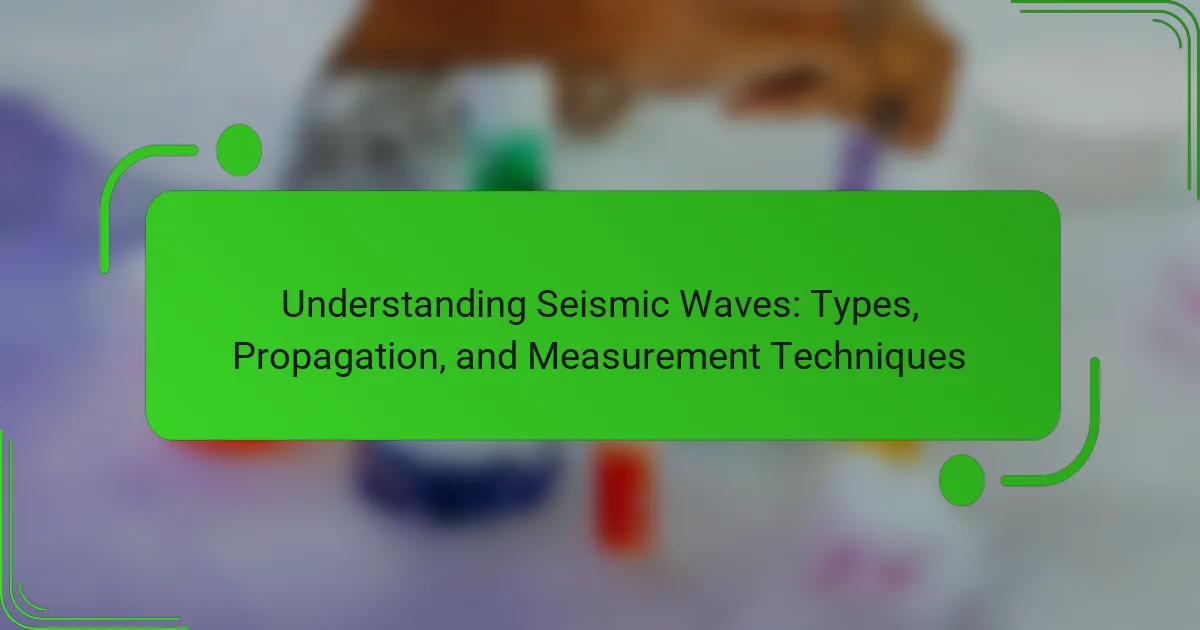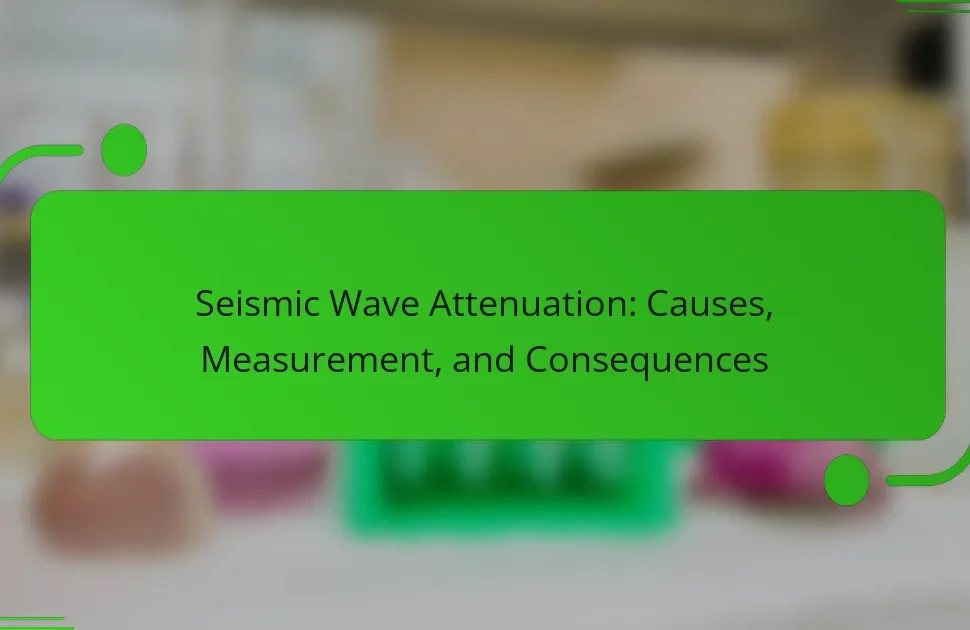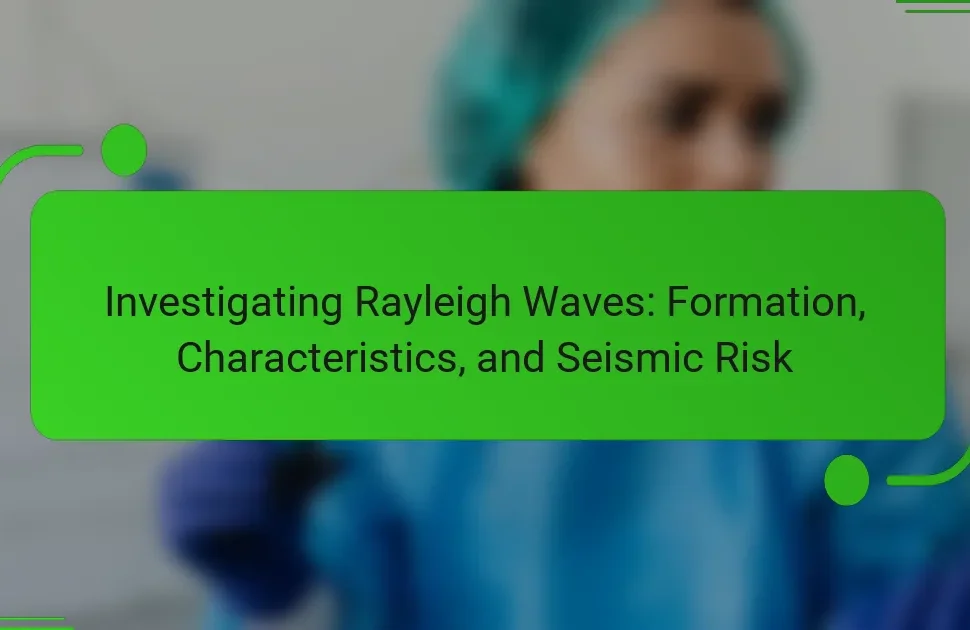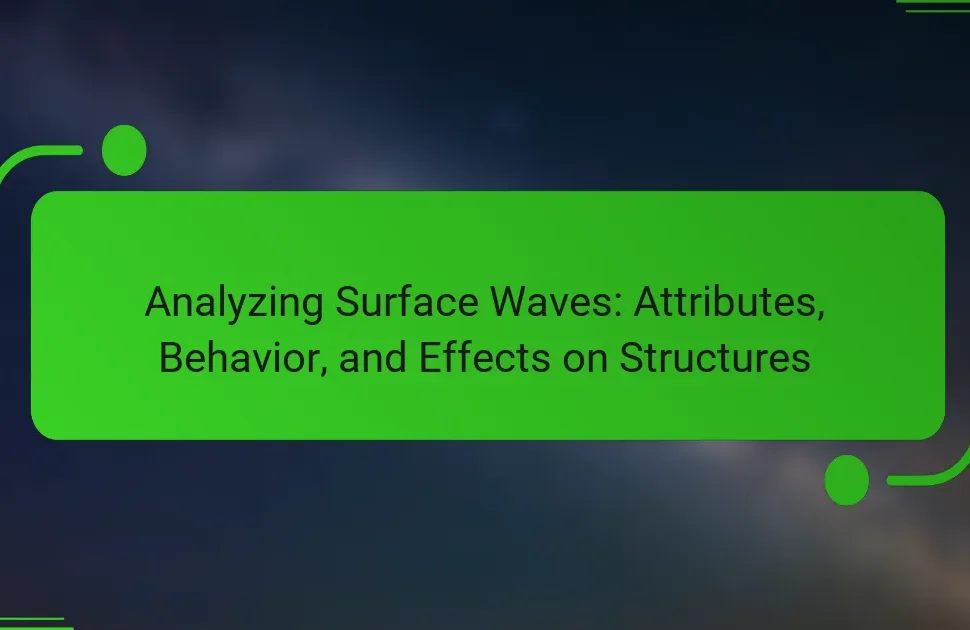Seismic waves are energy waves generated by geological events such as earthquakes and volcanic eruptions, traveling through the Earth’s layers. They are classified into two main types: body waves, which include primary (P) waves and secondary (S) waves that propagate through the Earth’s interior, and surface waves that travel along the Earth’s surface. The propagation of seismic waves is influenced by the Earth’s internal structure, including the crust, mantle, outer core, and inner core, leading to variations in speed and behavior based on material properties. Seismometers are used to measure these waves, converting ground motion into electrical signals recorded as seismograms, which help determine earthquake location and magnitude. Understanding seismic waves is essential for analyzing Earth’s structure and improving earthquake engineering practices.
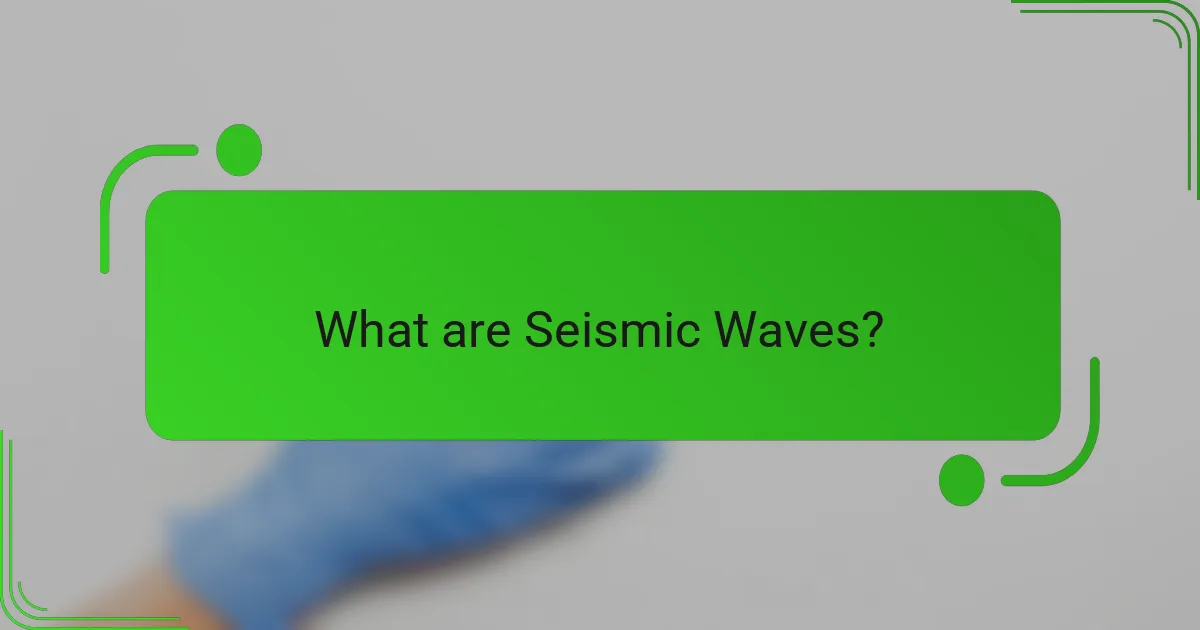
What are Seismic Waves?
Seismic waves are energy waves that travel through the Earth’s layers, generated by geological events. They occur during earthquakes, volcanic eruptions, and other tectonic activities. Seismic waves can be classified into two main types: body waves and surface waves. Body waves include primary (P) waves and secondary (S) waves, which travel through the Earth’s interior. P waves are compressional waves that move faster than S waves, which are shear waves. Surface waves travel along the Earth’s surface and typically cause more damage during seismic events. The study of seismic waves is crucial for understanding Earth’s structure and for earthquake engineering.
How do Seismic Waves form?
Seismic waves form due to the sudden release of energy in the Earth’s crust. This energy release typically occurs during an earthquake or volcanic activity. The movement of tectonic plates generates stress along faults. When the stress exceeds the strength of rocks, it causes a rupture. This rupture creates vibrations that propagate through the Earth. Seismic waves travel in various forms, including P-waves and S-waves. P-waves are compressional waves that move faster than S-waves. S-waves are shear waves that follow P-waves. The study of seismic waves helps in understanding Earth’s internal structure and predicting earthquakes.
What are the primary causes of Seismic Waves?
Seismic waves are primarily caused by the sudden release of energy in the Earth’s crust. This release often occurs due to tectonic plate movements. Earthquakes are a common source of this energy release. Volcanic activity can also generate seismic waves. Other causes include landslides and human activities, such as mining or explosions. The energy from these events creates vibrations that travel through the Earth. These vibrations are detected as seismic waves. The study of these waves helps scientists understand Earth’s internal structure and behavior.
How do geological factors influence Seismic Wave formation?
Geological factors significantly influence seismic wave formation. The composition of the Earth’s materials affects wave speed and behavior. Denser materials, such as granite, transmit seismic waves faster than less dense materials like sediment. The layering of geological formations also impacts wave propagation. Waves may reflect, refract, or diffract when encountering different rock types. Additionally, the presence of faults and fractures can create complex wave patterns. Variations in temperature and pressure within the Earth can alter wave characteristics as well. For example, higher temperatures may reduce wave velocity in certain materials. Overall, the geological context is crucial for understanding seismic wave dynamics.
What are the different types of Seismic Waves?
There are three primary types of seismic waves: P-waves, S-waves, and surface waves. P-waves, or primary waves, are compressional waves that travel fastest through the Earth. They can move through solids, liquids, and gases. S-waves, or secondary waves, follow P-waves and only travel through solids. They are slower than P-waves and cause more damage during earthquakes. Surface waves travel along the Earth’s surface and are responsible for most of the shaking felt during an earthquake. They typically cause the most destruction due to their higher amplitude and longer duration. Each type of seismic wave plays a crucial role in understanding earthquake dynamics and the Earth’s internal structure.
What are the characteristics of Primary Waves (P-Waves)?
Primary Waves (P-Waves) are seismic waves that are the first to arrive during an earthquake. They are longitudinal waves, meaning they compress and expand the material they travel through. P-Waves can move through solids, liquids, and gases. Their speed typically ranges from 5 to 8 kilometers per second in the Earth’s crust. These waves cause particles to oscillate in the same direction as the wave is traveling. P-Waves are less damaging compared to other seismic waves, like S-Waves. They are detected by seismographs, which measure their arrival times to help locate earthquakes. The ability to travel through different states of matter is a key characteristic that distinguishes P-Waves from other seismic waves.
How do Secondary Waves (S-Waves) differ from P-Waves?
Secondary Waves (S-Waves) differ from Primary Waves (P-Waves) in their mode of propagation. S-Waves are shear waves that move through the Earth by displacing material perpendicular to the direction of wave travel. In contrast, P-Waves are compressional waves that move by compressing and expanding the material in the same direction as the wave travels.
S-Waves cannot travel through liquids, which is why they are not detected in the Earth’s outer core. P-Waves, however, can travel through both solids and liquids, making them detectable in all layers of the Earth. The speed of S-Waves is also slower than that of P-Waves. Typically, S-Waves travel at about 60-70% the speed of P-Waves in the same medium.
These differences are crucial in seismology. They help scientists determine the composition and state of Earth’s internal layers based on the behavior of these waves during seismic events.
What are surface waves and how do they behave?
Surface waves are seismic waves that travel along the Earth’s surface. They are generated by earthquakes or artificial sources. Surface waves typically cause the most damage during seismic events. They move slower than body waves, which travel through the Earth’s interior. There are two main types of surface waves: Love waves and Rayleigh waves. Love waves move horizontally, causing side-to-side motion. Rayleigh waves create an elliptical motion, similar to ocean waves. Surface waves can travel long distances and are responsible for the shaking felt during an earthquake. Their behavior is influenced by the Earth’s surface materials and geological structures.
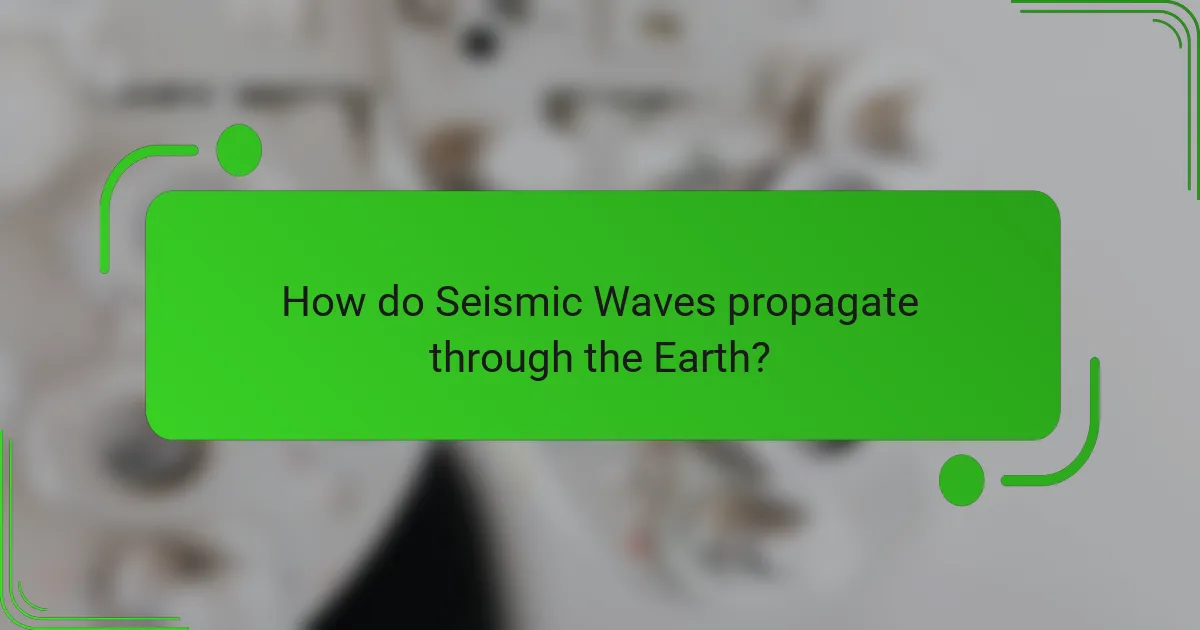
How do Seismic Waves propagate through the Earth?
Seismic waves propagate through the Earth by traveling through different layers of the planet. These waves are generated by energy released during earthquakes or other geological activity. There are two primary types of seismic waves: body waves and surface waves. Body waves include primary (P) waves and secondary (S) waves. P waves are compressional waves that travel fastest through solid and liquid materials. S waves are shear waves that can only move through solid materials and travel slower than P waves.
As seismic waves travel, they change speed and direction depending on the properties of the Earth’s materials they encounter. For example, waves move faster through denser materials. The Earth’s structure consists of the crust, mantle, outer core, and inner core, each with different densities and compositions. This layered structure causes waves to refract and reflect, leading to complex propagation patterns.
In summary, seismic wave propagation is influenced by the Earth’s internal structure and material properties, resulting in varied wave behaviors.
What factors affect the propagation of Seismic Waves?
The propagation of seismic waves is affected by several factors. These include the type of wave, the medium through which they travel, and the geological conditions. Seismic waves can be classified into primary waves (P-waves) and secondary waves (S-waves). P-waves travel faster and can move through solids and liquids, while S-waves only travel through solids.
The medium’s density and elasticity significantly influence wave speed. Denser and more elastic materials allow for faster wave propagation. Geological structures, such as faults and layers of rock, can also alter wave paths. Changes in temperature and pressure within the Earth affect the properties of these materials, further impacting wave behavior.
Additionally, the frequency of seismic waves can determine how they interact with different materials. Higher frequency waves tend to be absorbed more quickly in softer materials. These factors collectively dictate how seismic waves propagate through the Earth.
How does the Earth’s composition influence Seismic Wave speed?
The Earth’s composition directly influences seismic wave speed. Seismic waves travel faster through denser materials. The Earth’s inner core, composed mainly of iron and nickel, has high density. This density allows seismic waves to travel at speeds of approximately 11 km/s.
In contrast, seismic waves move slower through less dense materials like the Earth’s crust. The average seismic wave speed in the crust is about 6 km/s. Variations in composition, such as the presence of water or minerals, also affect wave speed. For example, seismic waves slow down in saturated sediments compared to dry sediments.
Overall, the Earth’s layered structure, with varying compositions, creates distinct seismic wave speeds. This relationship is crucial for understanding earthquake dynamics and the Earth’s internal structure.
What role does temperature and pressure play in Seismic Wave propagation?
Temperature and pressure significantly influence seismic wave propagation. Increased temperature generally decreases the density of rocks, affecting wave speed. Conversely, higher pressure increases rock density, which can enhance wave velocity.
Seismic waves travel faster in denser materials. For instance, in the Earth’s crust, pressure increases with depth, leading to higher wave speeds. Studies show that seismic waves can travel 30% faster in high-pressure environments compared to low-pressure conditions.
Temperature also affects material properties, such as viscosity and elasticity, which influences wave behavior. For example, molten rocks have different wave propagation characteristics than solid rocks. Overall, both temperature and pressure are crucial in determining the speed and behavior of seismic waves.
What are the key properties of Seismic Wave propagation?
Seismic wave propagation is characterized by several key properties. These include velocity, frequency, wavelength, and amplitude. The velocity of seismic waves varies based on the medium they travel through. For instance, P-waves travel faster than S-waves in the Earth’s crust. Frequency refers to the number of wave cycles that pass a point in a given time. Higher frequency waves typically carry more energy. Wavelength is the distance between successive crests of a wave. It is inversely related to frequency. Amplitude measures the height of the wave, indicating the energy level of the seismic wave. These properties are essential for understanding how seismic waves behave and are measured during geological events.
How does frequency affect Seismic Wave behavior?
Frequency influences seismic wave behavior significantly. Higher frequency waves travel faster and are more sensitive to small geological features. They tend to attenuate quickly, losing energy as they penetrate the Earth. Lower frequency waves, in contrast, can travel longer distances with less attenuation. They are often associated with larger, more destructive seismic events. Research shows that frequency content affects the amplitude and duration of seismic shaking. For instance, the 2011 Tōhoku earthquake demonstrated how frequency variations impacted ground motion across different regions. Understanding these frequency effects is crucial for earthquake engineering and risk assessment.
What is the significance of amplitude in Seismic Waves?
Amplitude in seismic waves signifies the energy and intensity of the waves. Higher amplitude indicates stronger seismic waves, which can lead to more significant ground shaking. This shaking can cause damage to structures and influence the assessment of earthquake magnitude. Seismographs measure amplitude to determine the earthquake’s strength. The amplitude is crucial for understanding the potential impact of seismic events. In summary, amplitude directly correlates with the destructive capacity of seismic waves.
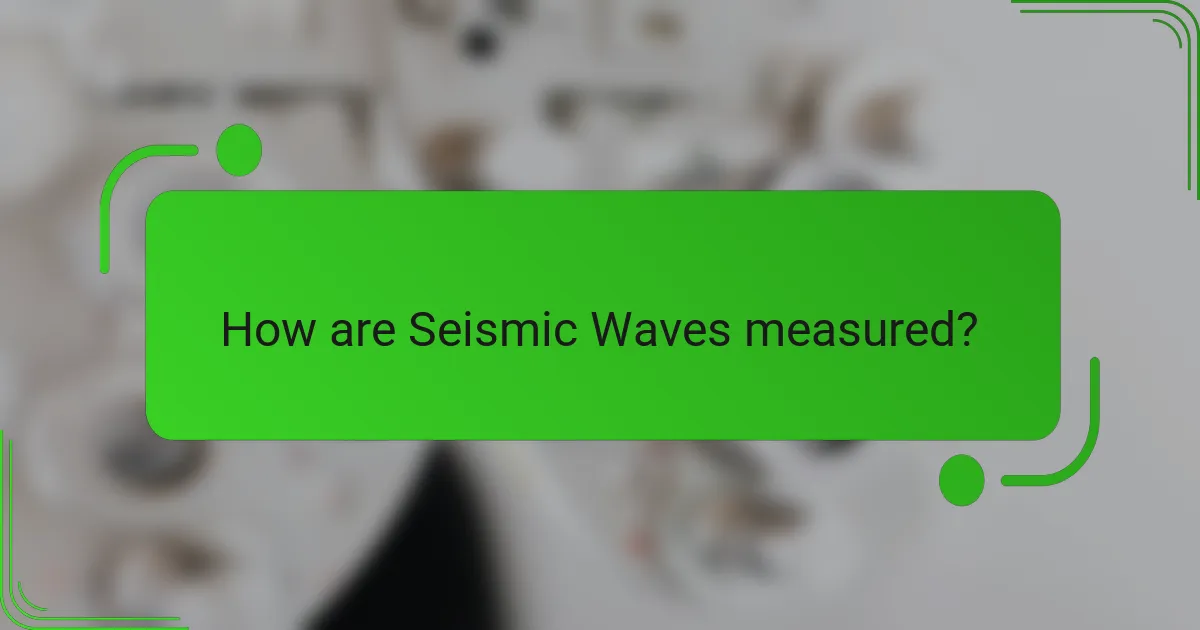
How are Seismic Waves measured?
Seismic waves are measured using instruments called seismometers. These devices detect ground motion caused by seismic waves. Seismometers convert the motion of the ground into electrical signals. The signals are then recorded on a computer or paper as seismograms. Seismograms display the amplitude and frequency of the waves. Different types of seismic waves, such as P-waves and S-waves, are analyzed through these recordings. The data helps determine the location and magnitude of earthquakes. Seismometers are often deployed in networks to provide real-time monitoring of seismic activity.
What instruments are used to measure Seismic Waves?
Seismic waves are measured using instruments called seismometers. Seismometers detect and record the motion of the ground caused by seismic waves. They consist of a mass suspended on a spring, which moves in response to ground motion. This movement generates an electrical signal that is recorded for analysis.
There are different types of seismometers, including broadband and strong-motion seismometers. Broadband seismometers can detect a wide range of frequencies. Strong-motion seismometers are designed to measure high-amplitude ground shaking.
Seismographs are similar instruments that also record seismic waves. They provide visual representations of the seismic activity on paper or digital displays. Both seismometers and seismographs are essential for understanding earthquakes and seismic activity. Their data helps scientists assess the magnitude and impact of seismic events.
How do seismographs work in recording Seismic Waves?
Seismographs record seismic waves by detecting ground motion caused by earthquakes. They consist of a mass suspended on a spring, which remains stationary while the ground moves. When seismic waves reach the seismograph, the ground shakes and causes the mass to move. This relative motion between the mass and the ground is captured by the instrument. The movement is converted into an electrical signal. This signal is then recorded on a rotating drum or digital storage. The recorded data is displayed as a seismogram. Seismograms provide information about the amplitude and frequency of the seismic waves. This data helps in analyzing the characteristics of earthquakes.
What advancements have been made in Seismic measurement technology?
Recent advancements in seismic measurement technology include the development of high-sensitivity sensors. These sensors can detect smaller seismic events than ever before. Advances in digital signal processing have improved the accuracy of data interpretation. Real-time data transmission has enhanced the speed of seismic monitoring. The integration of machine learning algorithms allows for better event classification. Enhanced array configurations increase spatial resolution in seismic imaging. Additionally, the use of fiber optic cables has improved data acquisition over long distances. These innovations collectively lead to more precise and timely earthquake detection and analysis.
What techniques are utilized for analyzing Seismic data?
Seismic data analysis utilizes techniques such as seismic reflection, seismic refraction, and surface wave analysis. Seismic reflection involves sending waves into the ground and analyzing the reflected waves to identify subsurface structures. Seismic refraction measures the bending of seismic waves as they pass through different materials to determine layer properties. Surface wave analysis focuses on waves that travel along the Earth’s surface, providing information on shallow subsurface characteristics. These techniques are essential for applications like oil and gas exploration, earthquake studies, and geological mapping.
How is data processed to interpret Seismic Wave patterns?
Data processing to interpret seismic wave patterns involves several steps. First, raw seismic data is collected using sensors called seismometers. These instruments detect ground motion caused by seismic waves. The collected data is then digitized for analysis.
Next, signal processing techniques are applied. Filtering removes noise from the data. This enhances the clarity of the seismic signals. Time-series analysis helps in identifying wave arrivals.
Seismic waveforms are then analyzed to determine their characteristics. Attributes such as amplitude, frequency, and duration are extracted. These attributes provide insights into the source and nature of the seismic event.
Finally, interpretation is conducted using models of wave propagation. This helps in understanding the geological structures involved. The accuracy of interpretations is often validated against known seismic events.
What role does computer modeling play in Seismic analysis?
Computer modeling plays a critical role in seismic analysis by simulating the behavior of seismic waves. These models help predict how waves propagate through different geological structures. They allow researchers to analyze various scenarios, such as earthquake impacts on buildings and infrastructure. Advanced algorithms process real-time data to enhance accuracy. For instance, finite element modeling is commonly used to assess structural responses during seismic events. This approach has been validated by numerous studies, including research from the U.S. Geological Survey. The integration of computer modeling in seismic analysis significantly improves risk assessment and mitigation strategies.
What practical applications do Seismic Wave measurements have?
Seismic wave measurements have several practical applications. They are primarily used in earthquake engineering to assess building safety. Seismic data helps in designing structures that can withstand tremors. Additionally, these measurements are crucial in oil and gas exploration. They allow geologists to map underground resources accurately. Seismic waves are also used in environmental studies to monitor subsurface contamination. Furthermore, they assist in understanding geological formations. This information is vital for land-use planning and hazard assessment. Overall, seismic wave measurements are integral to multiple fields, enhancing safety and resource management.
How are Seismic Waves used in earthquake prediction?
Seismic waves are crucial in earthquake prediction as they provide data on the Earth’s internal structure. These waves are generated by tectonic movements and can be measured using seismographs. By analyzing the speed and behavior of seismic waves, scientists can identify stress accumulation along fault lines. This information helps in assessing the likelihood of an impending earthquake. For instance, the P-wave, which travels faster than the S-wave, can indicate the location and magnitude of seismic activity. Historical data shows that regions with frequent seismic wave activity are more prone to earthquakes. Thus, monitoring seismic waves is essential for early warning systems and risk assessment.
What is the importance of Seismic data in civil engineering?
Seismic data is crucial in civil engineering for assessing site safety and structural integrity. It helps engineers understand ground motion and potential earthquake impacts. This data informs the design of buildings and infrastructure to withstand seismic forces. Accurate seismic data allows for risk assessment and mitigation strategies. Engineers use this information to create safer structures in earthquake-prone areas. Studies show that incorporating seismic data reduces damage during seismic events. For instance, the 1994 Northridge earthquake highlighted the need for seismic design standards. Proper analysis of seismic data can save lives and minimize economic losses.
How can one effectively study Seismic Waves?
To effectively study seismic waves, one should utilize a combination of theoretical knowledge and practical applications. Understanding the principles of wave mechanics is essential. This includes grasping concepts such as wave types, propagation speeds, and energy transfer.
Engaging with seismic data through software tools enhances practical skills. Programs like MATLAB or Python libraries can analyze seismic waveforms. Students should also participate in field studies to observe seismic phenomena directly.
Attending workshops or seminars led by geophysicists provides insight into current research and methodologies. Reading academic journals, such as the Bulletin of the Seismological Society of America, offers exposure to recent findings in the field.
Collaborating with peers on projects encourages knowledge exchange and deeper understanding. Utilizing simulation tools can also help visualize seismic wave behavior in various geological settings.
What resources are available for learning about Seismic Waves?
Books, academic journals, and online courses are essential resources for learning about seismic waves. Notable books include “Introduction to Seismology” by Peter M. Shearer. This book covers fundamental concepts and provides in-depth analysis. Academic journals like the “Bulletin of the Seismological Society of America” publish peer-reviewed research on seismic activities. Online platforms such as Coursera and edX offer courses on seismology. These courses are designed by universities and provide structured learning. Additionally, the United States Geological Survey (USGS) website offers educational materials and real-time data on seismic events. These resources are widely recognized for their accuracy and educational value.
What best practices should be followed when measuring Seismic Waves?
To measure seismic waves accurately, use calibrated instruments and appropriate locations. Ensure that seismometers are installed on stable ground to minimize noise. Regularly check and maintain equipment to ensure optimal performance. Use a variety of sensors to capture different wave types. Record data continuously to capture transient events. Implement standardized protocols for data collection and analysis. Analyze data using established methodologies to ensure consistency. These practices enhance the reliability of seismic measurements, as evidenced by improved data quality in studies like the USGS’s Earthquake Hazards Program.
Seismic waves are energy waves generated by geological events such as earthquakes and volcanic eruptions, traveling through the Earth’s layers. The article provides a comprehensive overview of seismic waves, detailing their types, including primary (P) waves, secondary (S) waves, and surface waves, along with their formation, propagation, and the geological factors influencing their behavior. It also discusses measurement techniques, the significance of seismic data in fields like civil engineering and earthquake prediction, and best practices for studying seismic waves. Key properties such as velocity, frequency, amplitude, and the impact of temperature and pressure on wave propagation are highlighted to enhance understanding of seismic dynamics.
